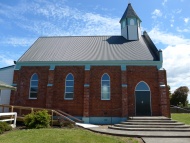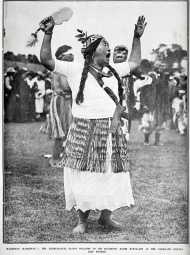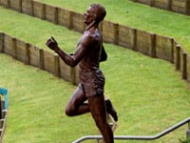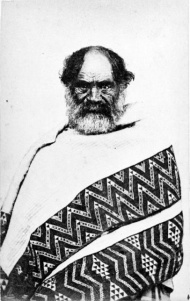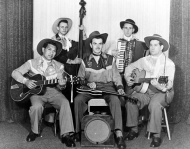Events In History
-
 9 September 1976Wanganui Computer legislation enacted
9 September 1976Wanganui Computer legislation enacted'Big Brother is watching'? The government's establishment of New Zealand's first centralised electronic database through the Wanganui Computer Centre Act raised questions about the state's ability to gather information on its citizens. Read more...
-
 27 January 1962Peter Snell breaks world mile record
27 January 1962Peter Snell breaks world mile recordWidely considered one of the greatest middle-distance runners of all time, Snell broke Herb Elliott's world record on grass at Cooks Gardens, Whanganui, covering the distance in 3 minutes 54.4 seconds. Read more...
-
 3 May 1929Controversial ex-mayor killed in Berlin riots
3 May 1929Controversial ex-mayor killed in Berlin riotsCharles Ewing Mackay, the disgraced former mayor of Whanganui, was shot dead by Berlin police during May Day riots in the German capital. Read more...
-
 15 May 1920Whanganui mayor shoots poet
15 May 1920Whanganui mayor shoots poetWalter D'Arcy Cresswell alleged that Mayor Charles Mackay had made homosexual advances towards him. Mackay was convicted of attempted murder and sentenced to 15 years' hard labour. Read more...
-
 9 February 1900Wanganui Opera House opened
9 February 1900Wanganui Opera House openedOpened by Premier Richard Seddon, this large wooden building has been one of Whanganui's finest entertainment venues for more than a century Read more...
-
 18 April 1847Gilfillan killings near Whanganui
18 April 1847Gilfillan killings near WhanganuiA Māori raid on the Gilfillan farm at Matarawa, just east of Whanganui, left four members of the family dead. The artist John Gilfillan and one of his daughters were severely wounded. Read more...
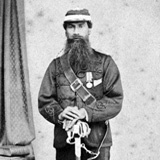 Te Keepa Te Rangihiwinui
Te Keepa Te Rangihiwinui
Muaūpoko, Ngāti Apa and Whanganui chief who joined the Armed Police Force and fought in campaigns against the Hauhau, Te Kooti and Tītokowaru during the 1860s.
Read more... John Bryce
John Bryce
Native Minister who was in charge at the time 1,600 Armed Constabluary destroyed the settlement of Parihaka in November 1881
Read more... James K Baxter
James K Baxter
Acknowledged as New Zealand’s most accomplished poet, Baxter is also well known for his lifestyle and the counter-cultural community he established beside the Whanganui River.
Read more...Articles
War in Whanganui

The confusion and uncertainty that had surrounded the New Zealand Company's land purchases in Whanganui erupted into violence in the autumn and winter of 1847. The conflict here also involved longstanding rivalries between upper and lower Whanganui River Māori.
-
Page 2 – Background
From the outset there was confusion and uncertainty over the exact nature and extent of the New Zealand Company's purchase at Whanganui.
-
Page 3 – The Matarawa killings
The killing of Mary Gilfillan and three of her children caused tension between upriver and downriver Māori as well as among Europeans.
-
Page 4 – The siege of Whanganui
Te Mamaku led 700 Ngāti Hāua-te-rangi warriors who attacked Whanganui in May 1847.
-
Page 5 – Moutoa Island
The Pai Mārire religion divided Māori. Some supported it, but others mistrusted its political intent. Events on the Whanganui River in 1864 showed the conflict about the faith
-
Page 6 – The 1865 campaign
Following the battle of Moutoa Island in 1864, Hipango pursued the retreating Pai Mārire (Hauhau) warriors. Fighting continued from fortified positions upriver near Hiruhārama
The 1920s

The 1920s was the decade that modern New Zealand came of age. Despite political and economic uncertainty, the country shrugged off the gloom of war to embrace the Jazz Age - an era of speed, power and glamour. Explore an overview of the decade and a year-by-year breakdown of key events.
- Page 3 - 1920 - key eventsA selection of key New Zealand events from
Election Days

When New Zealanders go to the polls on 26 November 2011, they will continue a 158-year-old tradition of parliamentary democracy in this country. Politics may have changed beyond recognition since 1853, but the cut and thrust of the campaign trail, the power of advertising, and the drama of polling day remain as relevant as ever.
- Page 4 - Nights on the townAfter the colour and controversy of the 1850s, election days in New Zealand have generally been orderly affairs. Even so, election nights could still be lively
Regional rugby

The passion and parochialism of provincial rugby has helped give the game a special place in New Zealand’s social and sporting history. Read brief histories, highlights and quirky facts about each of New Zealand's 26 regional rugby teams.
- Page 16 - Whanganui rugbyHistory and highlights of rugby in the Whanganui
Related keywords
- conscientious objection
- WW1 home front
- putiki
- roll of honour
- railways
- german samoa occupation
- pioneer battalion
- maori in war
- gisborne
- NZ Wars memorial
- new zealand wars
- whanganui war
- te keepa te rangihiwinui
- crime
- john gilfillan
- charles mackay
- voting
- alcohol
- elections
- christchurch
- protest
- topine te mamaku
- music
- historic places
- whanganui river
- roadside stories
- moutoa gardens
- poetry
- athletics
- peter snell
- mete kingi paetahi
- hori te anaua
- running
- hoani hipango
- war memorials
- john bryce
- riwha titokowaru
- parihaka attack
- maori land
- rugby
- all blacks
- bill osborne
- muaupoko
- major kemp
- maori leaders
- te reo māori
- royalty
- olympics
- 1920s
- pai marire
- springboks
- south africa
- king country
- south african war
- painting
- public holidays
- empire day
- health
- tainui
- eva rickard
- nukumaru
- carving
- tourism
- transport
- WW1
- children
- cadets
- marist brothers
- moutoa
- flags
- james k baxter
- writing
- alternative lifestyle
- archibald baxter
- advertising
- mabel howard
- music month
- johnny devlin
- johnny cooper
Situated at the mouth of the Whanganui River, and ancestral home to Te Āti Haunui-a-Pāpārangi hapu, Whanganui is one of New Zealand's oldest cities. It was the New Zealand Company’s second settlement, and began as an adjunct of the first, Wellington, in 1840. In the mid 1860s the town was under threat of attack by Pai Mārire adherents. Redoubts (fortifications) were built to the north-west and along the river, and troops were deployed. Whanganui became a city in 1924, when it was New Zealand’s largest urban area after the four main centres. Slow growth in the hinterland also hindered Whanganui’s growth during the latter half of the twentieth century, but a diversified economy has seen the town grow in the last few decades.




